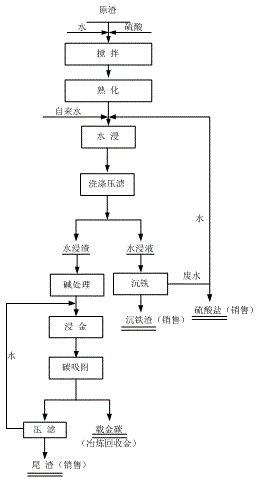Method for recycling gold from roasting residues or roasting-leaching residues of gold concentrate
A technology for gold concentrate and roasting slag, applied in the field of gold recovery, can solve the problems of difficult flue gas treatment, complicated process, high environmental pressure, etc., and achieves the effects of being suitable for production and application, accelerating the reaction rate, and improving the conversion rate.
- Summary
- Abstract
- Description
- Claims
- Application Information
AI Technical Summary
Problems solved by technology
Method used
Image
Examples
Embodiment 1
[0026] Utilize the present invention to process a kind of gold concentrate roasting-cyanide leaching slag (raw material slag, see Table 1 for chemical analysis results) containing 6.90g / t of gold, comprising the following steps:
[0027] (1) First add 1 part of raw material slag to the reactor, then add water equivalent to 20.65% of the mass of raw material slag, and stir evenly; then add 1.3 parts of sulfuric acid solution with a mass concentration of 98%, namely: raw material slag: water: 98wt The ratio of % concentrated sulfuric acid is 1:0.2065:1.3, stir evenly, and then keep it sealed at 110°C for 1 hour to mature; then add water 3 times the quality of raw material slag to make slurry, stir and dissolve at 60°C for 0.5 hour, then filter and wash ; Use the same amount of water, temperature and dissolution time to re-pulp, dissolve, and filter and wash 3 times (that is, filter and wash 4 times) to obtain acid leaching residue (see Table 2 for chemical analysis results) and a...
Embodiment 2
[0036]Utilize the present invention to process the leaching slag (raw material slag, see Table 3 for chemical analysis results) after roasting-leaching copper of a kind of gold concentrate containing 11.34g / t of gold, comprising the following steps:
[0037] (1) First add 1 part of raw material slag to the reactor, then add water equivalent to 28.63% of the mass of raw material slag, stir and mix evenly; then add 1.1 parts of sulfuric acid solution with a mass concentration of 98%, namely: raw material slag: water: The ratio of 98wt% concentrated sulfuric acid is 1:0.2863:1.1, stir evenly, and then heat preservation at 80°C for 2 hours for aging; then add water twice the quality of raw material slag to make slurry, stir and dissolve at room temperature for 0.3 hours, and then filter and wash; Use the same amount of water, temperature and dissolution time to re-slurry, dissolve, and filter and wash twice (that is, filter and wash three times) to obtain acid leach residue and aci...
Embodiment 3
[0048] Using the present invention to process a gold concentrate roasting slag containing 35.25g / t of gold (raw material slag, the chemical analysis results of the raw slag are shown in Table 5), specifically comprising the following steps:
[0049] (1) First add 1 part of raw material slag to the reactor, then add water equivalent to 10% of the mass of raw material slag, stir and mix evenly; add 1.5 parts of sulfuric acid solution with a mass concentration of 80%, namely: raw material slag: water: 98wt The ratio of % concentrated sulfuric acid is 1:0.376:1.22, stir evenly, and then keep warm at 90°C for 1 hour to mature; then add 6 times the quality of raw material slag to make slurry, stir and dissolve at room temperature for 0.1 hour, then precipitate and decant Supernatant liquid (1st washing); then add water to the same amount of pulp, repeat the above operation, and wash 5 times in total to obtain acid leaching residue and acid leaching solution;
[0050] (2) Gold extrac...
PUM
 Login to View More
Login to View More Abstract
Description
Claims
Application Information
 Login to View More
Login to View More - Generate Ideas
- Intellectual Property
- Life Sciences
- Materials
- Tech Scout
- Unparalleled Data Quality
- Higher Quality Content
- 60% Fewer Hallucinations
Browse by: Latest US Patents, China's latest patents, Technical Efficacy Thesaurus, Application Domain, Technology Topic, Popular Technical Reports.
© 2025 PatSnap. All rights reserved.Legal|Privacy policy|Modern Slavery Act Transparency Statement|Sitemap|About US| Contact US: help@patsnap.com


